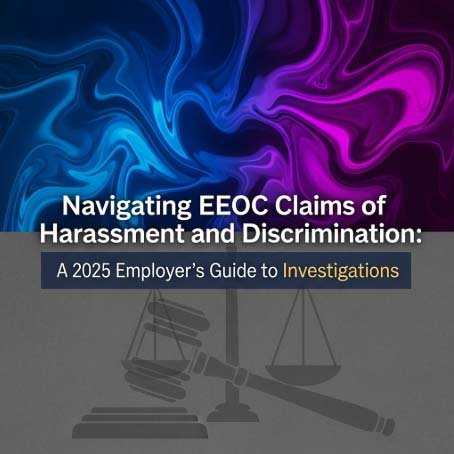Workplace harassment and discrimination claims continue to be a top compliance concern for employers in 2025. The U.S. Equal Employment Opportunity Commission (EEOC) enforces federal laws that prohibit workplace discrimination based on race, color, religion, sex (including pregnancy, sexual orientation, and gender identity), national origin, age (40+), disability, or genetic information.
For employers, receiving an EEOC charge can feel overwhelming. However, with the right approach, businesses can navigate the process effectively while protecting employees, company culture, and organizational reputation. This guide provides employers with practical strategies to handle EEOC harassment and discrimination investigations in 2025.
Understanding EEOC Claims in 2025
The EEOC has increased its focus on systemic discrimination, harassment prevention, and retaliation. Employers can expect:
- More digital investigations: EEOC portals streamline communication and document uploads.
- Broader harassment definitions: Gender identity, pregnancy accommodations, and remote-work harassment issues are gaining attention.
- Data-driven reviews: The agency is prioritizing claims where multiple employees allege similar treatment.
Step 1: Take Every Claim Seriously
Whether the allegation comes internally or via an EEOC charge, employers must treat it with urgency and respect. Dismissing or delaying action may worsen liability and increase penalties.
- Acknowledge receipt of the complaint.
- Assure the employee that retaliation is prohibited.
- Preserve confidentiality while following company protocols.
Step 2: Prepare for the EEOC Investigation
When a formal charge is filed, the EEOC notifies the employer. Deadlines for response are strict, so preparation is key.
- Review the charge carefully – identify the type of discrimination alleged.
- Gather evidence – emails, policies, time records, personnel files, and witness statements.
- Assign a point of contact – usually HR or legal counsel.
- Draft a clear position statement – your written response is critical; it should be factual, concise, and supported by documentation.
Step 3: Conduct an Internal Investigation
Parallel to responding to the EEOC, employers should conduct their own investigation.
- Interview involved parties and witnesses neutrally.
- Document findings thoroughly – facts, not assumptions.
- Take corrective action quickly if misconduct is found.
Proactive steps taken before the EEOC makes a determination often show good faith and may reduce liability.
Step 4: Cooperate While Protecting Employer Rights
Cooperation does not mean surrender. Employers should:
- Respond within deadlines.
- Provide only relevant documents.
- Consult with counsel before releasing sensitive data.
- Push back if requests are overly broad or burdensome.
Balancing compliance with protecting the organization’s legal interests is essential.
Step 5: Prevent Retaliation at All Costs
The EEOC consistently finds retaliation to be the most common violation. Employers must:
- Remind supervisors that retaliation is prohibited.
- Monitor workplace interactions.
- Ensure the complainant’s job duties, pay, and treatment remain fair.
Step 6: Implement Preventive Strategies for 2025 and Beyond
Prevention remains the best defense. Employers should:
- Update anti-harassment and discrimination policies annually.
- Train all employees, including managers, on recognizing and reporting misconduct.
- Offer multiple reporting channels (HR, anonymous hotlines, digital portals).
- Foster a workplace culture that values inclusion and respect.
What Happens After the Investigation?
The EEOC may:
- Dismiss the charge if no violation is found.
- Attempt mediation or conciliation.
- File a lawsuit in rare but serious cases.
Employers should use the outcome as an opportunity to reassess policies and strengthen workplace compliance.
Key Takeaways for Employers
- Always take claims seriously—ignore nothing.
- Respond promptly and factually to EEOC charges.
- Conduct thorough, impartial internal investigations.
- Prevent retaliation at all costs.
- Invest in long-term training and compliance strategies.
Final Thoughts
In 2025, navigating EEOC harassment and discrimination claims requires a balance of legal compliance, prompt action, and a commitment to workplace fairness. Employers who handle claims with transparency and care not only reduce legal risk but also build stronger, more inclusive workplaces.
By staying proactive and informed, your organization can turn a potential liability into an opportunity for cultural and organizational improvement.

